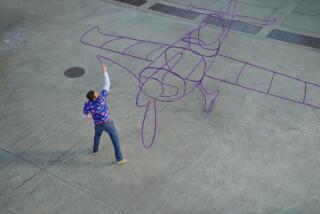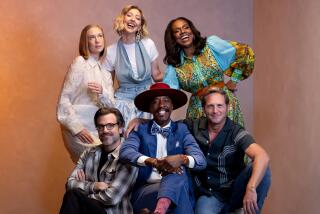Classic Hollywood: Hal Roach’s film legacy explored in Hollywood Museum exhibition
- Share via
Hollywood was the new frontier in 1914. With the film industry in its growing stages, even a former mule skinner by the name of Hal Roach could quickly become a major player.
Roach arrived in Hollywood in 1912 and found work as a stuntman and extra. Within two years, he had risen through the ranks, and Roach and his good friend, then-up-and-coming comedic genius Harold Lloyd, began their own production unit. And a century later fans are still laughing at the classic comedies Roach made at his studio.
The Hollywood Museum in the historic Max Factor Building is celebrating the centennial of the movie pioneer and the “lot of fun” with the new exhibition “100 Years of Hal Roach Studios: Laurel & Hardy, Our Gang and Harold Lloyd.”
“He was at the right place and the right time when the industry was being invented,” said film historian Richard Bann, who knew Roach the last 25 years of his life and co-wrote such books as “Laurel & Hardy” and “Our Gang: The Life and Times of the Little Rascals.”
“He was very enterprising and ambitious,” added Bann. “He had become close friends with Harold Lloyd and [directors] Frank Borzage and George Marshall. He realized his talents did not permit him to be an actor,” so he joined forces with the gifted Lloyd.
The producer-director was successful enough by 1919 that he was able to expand, building the Hal Roach Studios in Culver City. He launched the careers of Lloyd (“Safety Last”), created the enormously popular Our Gang comedy franchise and, most importantly, teamed Stan Laurel and Oliver Hardy, who became one the most beloved comedy teams in cinema history.
Other performers who worked at the studio included Will Rogers, Harry Langdon, Charley Chase, Patsy Kelly, Thelma Todd, Cary Grant, Jean Arthur, ZaSu Pitts and Jean Harlow.
Roach, who died in 1992 at age 100, also had an uncanny knack for finding and nurturing talent behind the camera. Such Oscar-winning directors as Leo McCarey (“The Awful Truth”), George Stevens (“A Place in the Sun,” “Giant”) and Frank Capra (“It Happened One Night,” “Mr. Deeds Goes to Town”) started at the studio.
Unlike his rival Mack Sennett, who focused solely on rapid-fire slapstick and sight gags, Roach’s comedies “have this unmistakable charm and style,” said Bann. “They are not just comedies of slapstick and spectacular stunts. There is a lot of personality and tender feelings — above all else, you like these people.”
“You felt like Laurel and Hardy were a couple of guys you felt like hanging around with,” noted Bob Satterfield, president of the San Bernardino “tent” of Sons of the Desert, the Laurel and Hardy appreciation society.
The exhibition, which continues through August, “really tells a story about this studio,” said Hollywood Museum curator Steve Nycklemoe. “People will learn about Hal Roach and what a smart man he was. He made wise choices.”
Many of the rare items in the exhibition were donated by collectors, particularly members of the Sons of the Desert, which is co-sponsoring the show in conjunction with its recent international convention in Hollywood.
The exhibition is an “information overload,” said Bann, who contributed several rare movie posters. Other items include Roach’s 1984 honorary Oscar, a menu from the studio’s Our Gang cafe, a blueprint of the entire layout of the studio, a collar worn by Our Gang’s Petey the Dog and Laurel and Hardy suits.
“Oliver Hardy’s suits were slightly small so it made him look even larger,” explained Nycklemoe.
The exhibition also features a recently discovered plaque from 1954 commemorating the name of the studio’s water tank, called Lake Laurel and Hardy because it had been used to drench the comedians in such films as 1934’s “Babes in Toyland.” The plaque had been missing since the studio was torn down in 1963.
Roach endured for four decades in Hollywood, said Bann, because was he was constantly evolving and “always ahead of the curve.”
In the late 1930s, Roach branched out into more sophisticated comedies like 1937’s “Topper” and such dramas as “Of Mice and Men,” the 1939 adaptation of John Steinbeck’s novel which earned four Oscar nominations, including for best picture. Roach got into TV production in the late 1940s, but the studio went bankrupt shortly after he sold his interests in 1955 to his son Hal Roach Jr.
Roach was also a rarity in Hollywood — a studio head who was a mensch. “Everyone from the directors to the grips loved what they were doing, and they worked in remarkable harmony,” said Bann. “I always quote Patsy Kelly — ‘Hal Roach was the best boss I ever had in the industry. I was practically ashamed to take the money.’”
Roach never lost his sense of humor. Satterfield, who became friends with the filmmaker near the end of his life, recalled he wasn’t happy when Laurel and Hardy comedies began to be colorized in the 1980s.
“I asked him at the time — ‘What do you think?’ He said, ‘Well, you read the newspaper funnies all week and when you get to Sunday it’s not any funnier because they are in color.’ I thought he hit the nail on the head.”
More to Read
Only good movies
Get the Indie Focus newsletter, Mark Olsen's weekly guide to the world of cinema.
You may occasionally receive promotional content from the Los Angeles Times.









